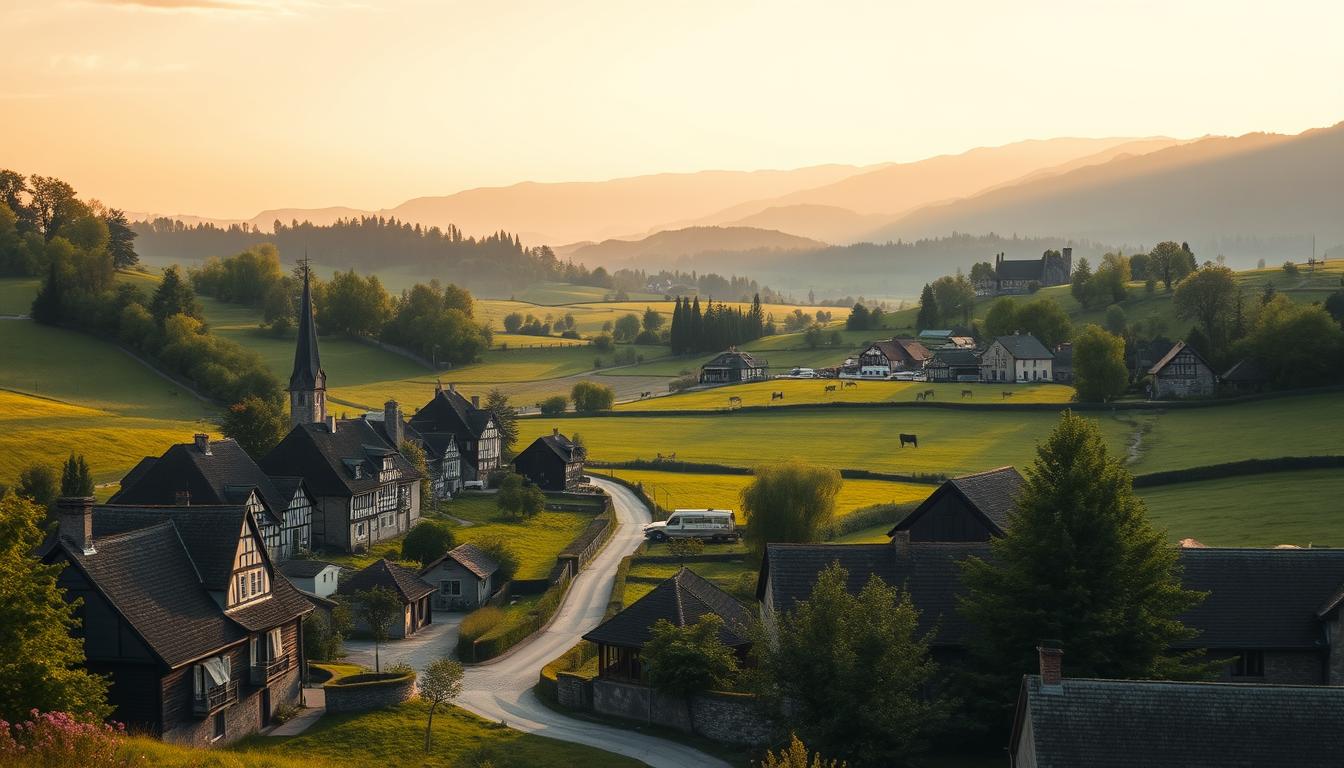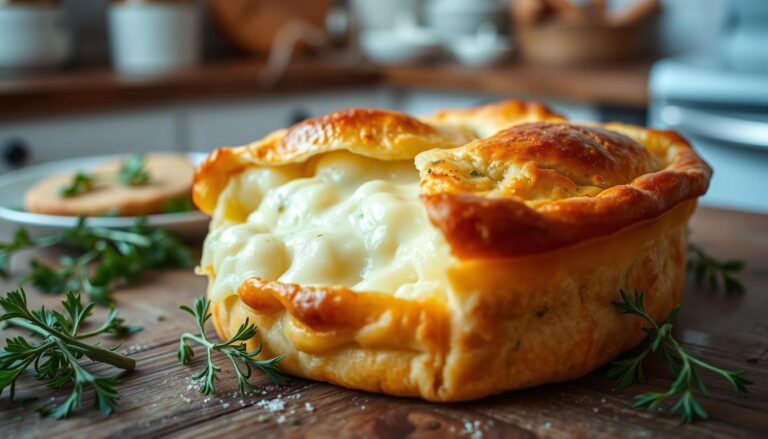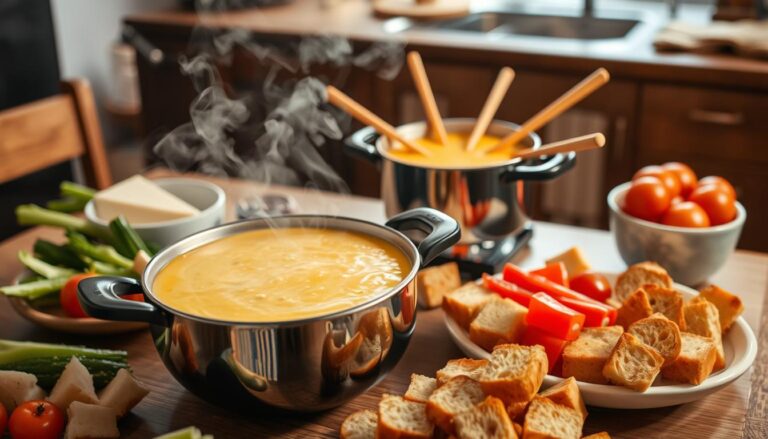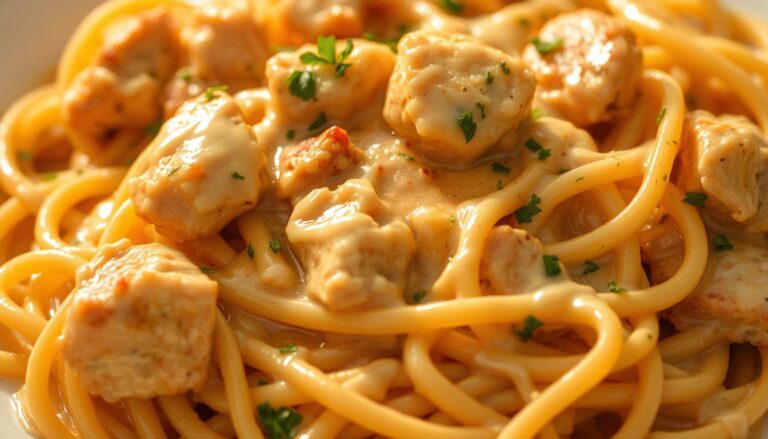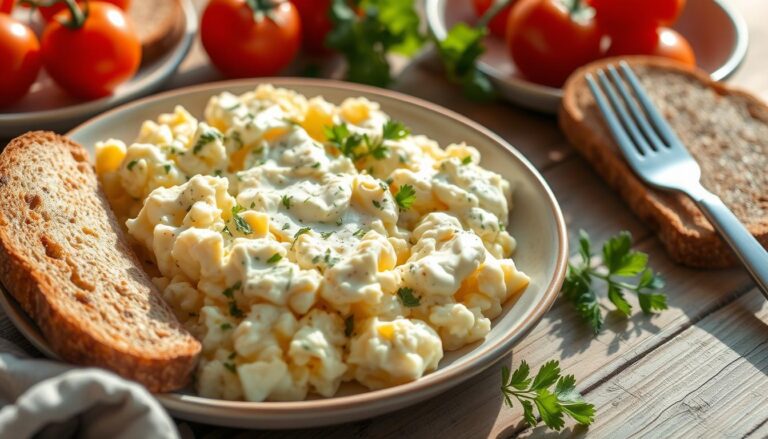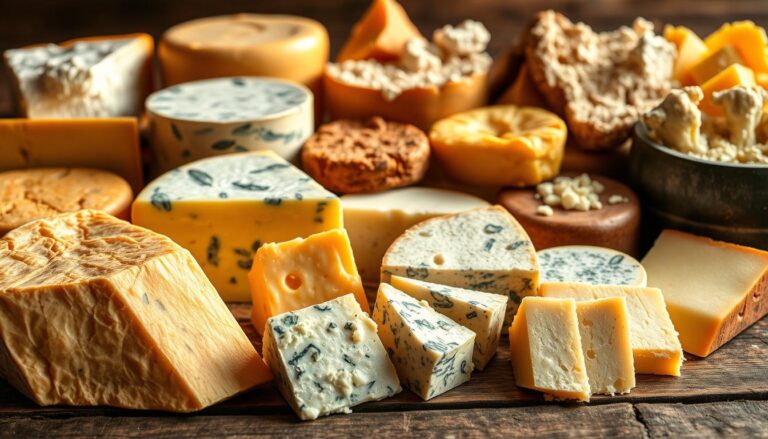Discover the Delicious World of Muenster Cheese
Muenster cheese is a mild, white cheese with a reddish-orange rind. This rind is made from paprika. It’s semi-firm in texture and has a mild smell that gets stronger as it ages1. To learn more, visit What is Muenster Cheese? and explore its rich history and production process. It’s produced in Germany, France, and the United States1, making it a beloved dairy product with a unique character.
Muenster cheese has a mild flavor that gets sharper and tangier as it ages1. It’s often described as a mix of mild cheddar and mozzarella1. Knowing its origin and history helps us appreciate its distinct taste and uses in various dishes.
Key Takeaways
- Muenster cheese is a mild, white cheese with a reddish-orange rind made from paprika1.
- Muenster cheese is produced in three countries: Germany, France, and the United States1.
- Muenster cheese has a mild flavor that intensifies as it ages, becoming more sharp and tangy1.
- Muenster cheese is often described as having a flavor profile that is a cross between mild cheddar and mozzarella1.
- Muenster cheese originated in Wisconsin, where it was inspired by the Munster cheese from France’s Alsace region2.
- Wisconsin cheesemakers have been producing cheese for over 175 years2.
What Is Muenster Cheese: Understanding This Beloved Dairy Product
Muenster cheese comes from cow’s milk and has a rich history. It started in the Alsace region of France and is also made in the United States3. It has a yellow-orange rind and a smooth, creamy texture. When comparing Muenster Cheese vs Cheddar, it’s essential to consider their distinct flavor profiles and textures. Muenster cheese is known for its mild, creamy flavor, while Cheddar has a sharper, more pronounced taste.
Understanding how to melt Muenster cheese is crucial for bringing out its full flavor and texture. With its excellent melting properties, Muenster cheese is ideal for grilled cheese sandwiches, macaroni and cheese, and pizza3. It contains 368 calories per 100 grams, with a fat content of 30 grams per 100 grams4. The aging process of Muenster cheese can range from a few weeks to several months, affecting its flavor and texture3.
Muenster cheese is a good source of calcium, essential for strong bones and teeth, as well as phosphorus, which supports healthy bone development5. Its lactose content is lower compared to fresh cheeses due to the fermentation and aging processes involved in its production5. Whether you’re a cheese aficionado or just discovering the world of Muenster, understanding its characteristics and uses can enhance your culinary experience.
The Rich History and Origins of Muenster Cheese
Muenster cheese has a long history, starting in the 7th century in Alsace, France6. It was first made by Cistercian monks. Their recipe became a favorite in the region. Over time, it spread to Europe and the world, with each place adding its own twist.
Muenster cheese became popular because it’s great in many dishes. You can find it in Best Recipes Using Muenster Cheese. It’s perfect for sandwiches, salads, casseroles, and even desserts. Its mild taste and creamy texture make it a favorite.
Today, Muenster cheese is made in many countries, including the U.S., Germany, and France. It’s usually made from cow’s milk, sometimes mixed with other milks. The cheese-making process involves heating the milk, adding bacteria and enzymes, and shaping it. It’s aged for weeks or months to get its flavor and texture7.
Some fun facts about Muenster cheese include its high calorie count, about 110 calories per ounce7. It’s also packed with nutrients like calcium, protein, and vitamins. The cheese’s orange rind comes from annatto8.
Muenster cheese has a long tradition in Alsace, France, recognized by the EU8. It’s also made in the U.S., where it’s milder and smoother6.
How Muenster Cheese Is Made: From Milk to Market
Muenster cheese production is a detailed process. It starts with pasteurizing milk and adding rennet and bacteria. The cheese ages for up to seven weeks9.
This process takes about 3.5 hours. The milk is heated to 100 degrees Fahrenheit for 30 minutes9. The cheese is then salted in a brine at 50 degrees Fahrenheit for 12 hours. It ripens at 60 degrees Fahrenheit with 85-95% humidity for 10-14 days9.
The cheese has a semisoft texture. Its color ranges from ivory to pale yellow with a reddish-orange rind10. It’s sold in blocks or pre-sliced formats. It’s often used with stronger cheeses in recipes10.
To learn more about cheese production, quality control is key. It ensures the highest quality Muenster cheese.
When melting Muenster cheese, the right techniques are crucial. How to Melt Muenster Cheese is a common question. The cheese’s high-fat content makes it perfect for melting and slicing9.
Muenster cheese is great in Best Sandwiches with Muenster Cheese, wraps, and paninis. Its mild flavor adds to various dishes10.
Distinctive Flavor Profile and Texture of Muenster
Muenster cheese is smooth and creamy, with a mild, nutty taste11. It’s milder than Cheddar, making it a great choice for those who prefer a softer cheese11. The cheese’s mild flavor means it’s not spicy11. It’s a semi-soft cheese, known for its smooth texture11.
The cheese has a unique orange rind, thanks to annatto dye11. This makes it stand out visually. Muenster cheese comes in different forms, each with its own taste and texture11. American Muenster, made from pasteurized cow’s milk, is milder and softer than the French version11.
For a tasty snack, check out cheesevibes.com to discover more about Muenster cheese. It’s perfect for grilled cheese, quesadillas, and burgers11. It also goes well with red and white wines, and fruits like apples, pears, and grapes11.

A Muenster grilled cheese sandwich has about 450 calories, 32 grams of carbs, 20 grams of protein, and 28 grams of fat11. Making one takes just 5 minutes to prepare and 5 minutes to cook, for a total of 10 minutes11.
Muenster vs Other Popular Cheeses: A Comparison Guide
There are many cheeses to choose from, each with its own taste and uses. We’ll compare Muenster cheese with Cheddar, Mozzarella, and American Cheese. This guide will show you the differences and similarities. It will also give you great recipes, like Muenster Cheese vs Cheddar recipes.
Muenster cheese is semi-soft and mild, perfect for all ages12. It goes well with many drinks, like stouts and chardonnay12. Cheddar, known for its sharp taste, is often used in place of Muenster in Best Recipes Using Muenster Cheese.
Here’s how Muenster cheese compares to others:
- Muenster vs Cheddar: Muenster is milder and great for sandwiches and salads.
- Muenster vs Mozzarella: Muenster is softer and perfect for pizzas and lasagnas.
- Muenster vs American Cheese: Muenster tastes more natural and is great for grilled cheese and burgers.
In summary, Muenster cheese is versatile and can be used in many dishes. Its mild flavor and soft texture make it ideal for melting. If you’re looking for a cheese for Best Recipes Using Muenster Cheese or want to try something new, Muenster is a great choice13.
Best Ways to Store and Preserve Muenster Cheese
To keep Muenster cheese fresh, it’s key to store it right. First, refrigerate it at 39°F (4°C) or below14. This stops bacteria and mold from growing. Also, keep it away from strong-smelling foods to avoid absorbing odors.
For those who love Best Sandwiches with Muenster Cheese, storing it well is important. Soft cheeses like Muenster last 7 to 10 days in the fridge15. Freezing can extend this to 12 months to two years, keeping flavor and meltability14.
For How to Melt Muenster Cheese, the right temperature and method are crucial. But, storing it correctly is a must first. Most cheeses prefer 34 to 38 degrees Fahrenheit16. Follow these tips to enjoy Muenster cheese longer and make tasty sandwiches.
Cooking with Muenster: Tips and Techniques
Cooking with Muenster cheese is a joy, thanks to its creamy texture and mild taste. To make the most of this cheese, learning how to melt Muenster cheese is key17. says melting it between 105°F (40°C) and 115°F (46°C) is best.
There are countless best recipes using Muenster cheese. It’s great in grilled cheese, cheese sauces, and more. For example, a mac and cheese recipe on cheesevibes.com highlights its melting skills. Muenster is also great in:
- Grilled cheese sandwiches
- Cheese sauces for pasta or veggies
- Casseroles and baked dishes
Knowing the right melting temperature and cooking methods can lead to tasty dishes with Muenster. Its mild taste and creamy texture make it perfect for many recipes. It’s a fantastic choice for any meal18.
Perfect Pairings: What Goes Well with Muenster
Muenster cheese is great with many foods, making delicious dishes. It’s a top pick for cheese pairings. For instance, Best Sandwiches with Muenster Cheese often have ham or turkey, and veggies like lettuce and tomato.
Compared to cheeses like Cheddar, Muenster is milder. It’s perfect for snacks and meals. The third web source suggests pairing it with fruits like apples and grapes, and nuts like almonds and walnuts. Sauvignon Blanc wine is also a great match, going well with cheeses like Cheddar, Gouda, and Monterey Jack, as well as Muenster19.
Here are some popular pairing options for Muenster cheese:
- Fruits: apples, grapes
- Nuts: almonds, walnuts
- Meats: ham, turkey
- Vegetables: lettuce, tomato
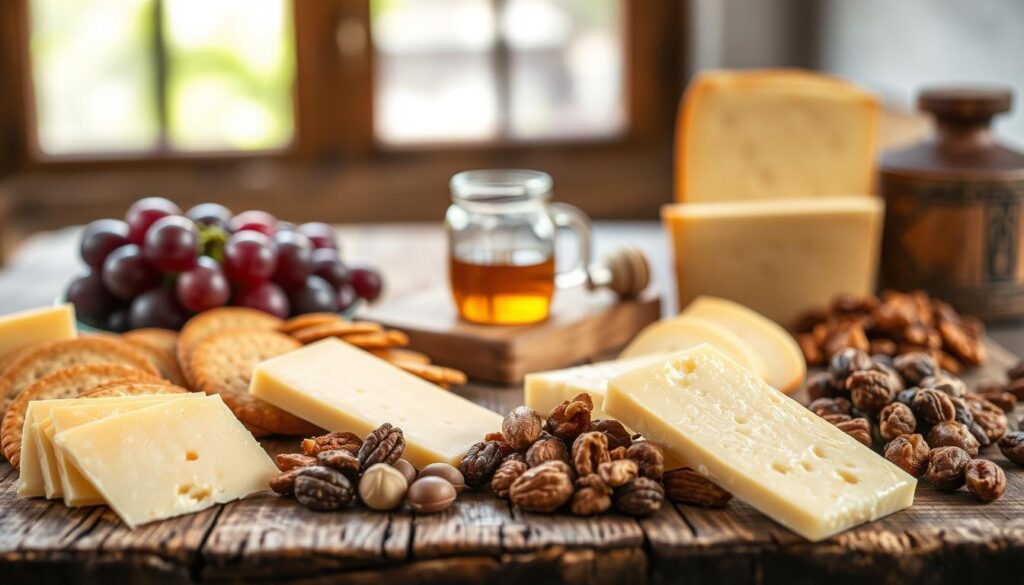
When pairing Muenster cheese, think about its flavor and texture. Its mild taste and creamy texture make it a great addition to any snack or meal. For more on perfect cheese pairings, check out cheesevibes.com20.
Popular Recipes Featuring Muenster Cheese
Muenster cheese is great for many dishes, like sandwiches and casseroles. It’s creamy and mild, making it perfect for many recipes. The Muenster Mac and Cheese is a top pick, needing 8 ounces of pasta, 1 cup of whole milk, and 8 ounces of shredded Muenster cheese21.
This recipe shows how Muenster cheese can make a dish rich and satisfying. It’s a favorite for its ability to melt well and add flavor.
Other favorites include grilled cheese sandwiches, cheese casseroles, and appetizers. These dishes show off the cheese’s melting and flavoring skills. Recipes with Muenster cheese can take from 15 minutes to 8 hours and 15 minutes22. It’s perfect for quick meals or more complex dishes.
Muenster cheese is also used in at least 15 different dishes23. You’ll find it in grilled cheese, macaroni and cheese, and stuffed chicken.
Here are some key ingredients and nutritional info for a Muenster Mac and Cheese recipe:
| Ingredient | Quantity |
|---|---|
| Pasta | 8 ounces |
| Whole milk | 1 cup |
| Muenster cheese | 8 ounces |
| Calories per serving | 398 |
Health Benefits and Nutritional Value of Muenster
Muenster cheese is packed with nutrients and offers many health benefits. It’s not spicy, so you don’t have to worry about that. It’s rich in protein, calcium, and probiotics24. Adding Muenster cheese to your diet can be a smart choice for your health.
Here are some key nutrients found in Muenster cheese:
- Calcium: approximately 200 mg per ounce, which is about 20% of the daily recommended intake25
- Protein: about 6 grams per ounce25
- Fat: roughly 8 grams per ounce25
Muenster cheese also has vitamins and minerals. But, it’s high in saturated fats and sodium. Eating too much can be harmful24. To get the most out of Muenster cheese, eat it in moderation.
In conclusion, Muenster cheese is a nutritious food that offers health benefits when eaten in moderation. Its high protein and calcium make it great for a healthy diet. Knowing the nutritional value of Muenster cheese lets you enjoy its taste while benefiting your health26.
Common Myths and Misconceptions About Muenster Cheese
Muenster cheese is often misunderstood. Many people wonder Is Muenster Cheese Spicy? or are unsure about its Muenster Cheese Origin and History. In reality, Muenster cheese is semi-soft with a mild taste, not spicy. It comes from the Alsace region in France, where monks made it in the 7th century27.
Some think Muenster cheese spoils quickly. But, soft cheeses like Brie and Camembert last up to 2 weeks in the fridge28. Muenster can last longer if wrapped right and kept cold. Keeping the cheese in a humid environment of 35-45% helps it stay fresh28.
If you want to know more about Muenster cheese, there are many resources. You can find articles and websites that explain its history and production. Learning the truth about Muenster cheese can make you appreciate its taste and texture even more.
Conclusion: Why Muenster Deserves a Place in Your Kitchen
Muenster cheese is a versatile and flavorful addition to any kitchen. Its creamy texture and mild taste make it perfect for many dishes. It’s great in grilled cheese sandwiches and hearty casseroles29.
Muenster cheese also has health benefits. It’s packed with protein, calcium, and vitamin B12. These nutrients support skin, hair, and nail health30. Plus, its zinc helps control oil and prevent acne30.
While it has some saturated fat and sodium, it’s okay in moderation. Cheese, including Muenster, can improve health. It supports muscle, bone, immune, and heart health30.
So, whether you’re making a gourmet grilled cheese or enjoying it as a snack, Muenster is a must-have. Its delicious flavor, versatility, and health benefits make it a favorite for cheese lovers29.
FAQ
What is Muenster Cheese?
Muenster cheese is a semi-soft cheese from the Alsace region of France. It has a distinctive orange-yellow rind. Its creamy texture is smooth.
How does Muenster Cheese compare to Cheddar Cheese?
Muenster cheese tastes milder than Cheddar. It’s softer and creamier than Cheddar’s firm texture.
What is the best way to melt Muenster Cheese?
Melt Muenster cheese at 140-160°F. You can melt it in the oven, on the stovetop, or in the microwave. But, avoid overheating to prevent it from becoming greasy or stringy.
What are some of the best sandwiches to make with Muenster Cheese?
Muenster cheese is great in grilled cheese, burgers, and deli sandwiches. Try it with ham, turkey, or sautéed onions and mushrooms.
Is Muenster Cheese spicy?
No, Muenster cheese is not spicy. It has a mild, nutty flavor without any heat.
What is the origin and history of Muenster Cheese?
Muenster cheese comes from the Alsace region of France. It was first made by Benedictine monks in the 7th century. It became famous in the Muenster region of Germany, earning its name.
What are some of the best recipes that use Muenster Cheese?
Muenster cheese is great in many dishes. Try it in grilled cheese, casseroles, pizza, and fondue. Popular recipes include Muenster mac and cheese, Muenster and mushroom quiche, and Muenster-stuffed burgers.

